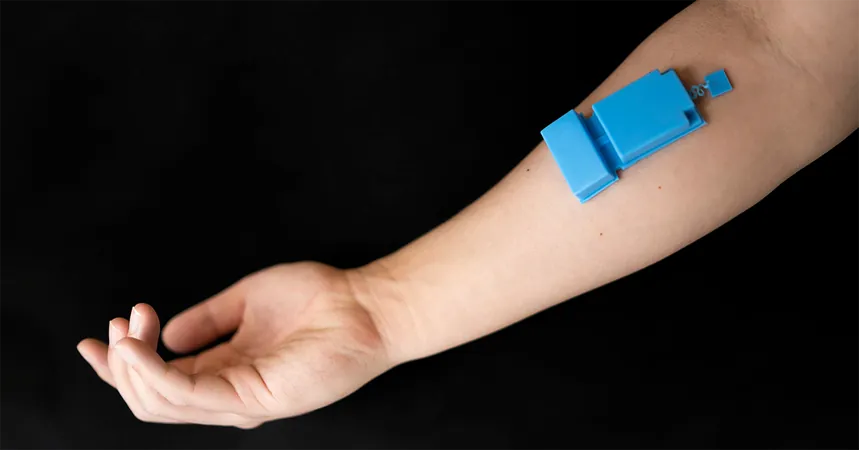
Revolutionary Wearable Ultrasound Device Set to Transform Muscle Monitoring in Healthcare and Beyond!
2024-10-31
Author: Yu
Introduction
Exciting advancements in wearable technology are emerging from the University of California San Diego. Engineers have developed an innovative wearable ultrasound device that allows for long-term, wireless monitoring of muscle activity, presenting game-changing applications in healthcare and even human-machine interfaces!
Research Overview
Led by Sheng Xu, a prominent professor in the Department of Chemical and Nano Engineering, the research team described their groundbreaking device in a paper published on October 31 in Nature Electronics. This collaboration includes experts like pulmonologist Jinghong Li, who is deeply invested in advancing medical technology.
Device Functionality
The device, which adheres to the skin and runs on battery power, provides a non-invasive method to track muscle function with high-resolution precision. In trials, it was successfully used to monitor diaphragm motion and thickness, crucial indicators for assessing respiratory health. "By tracking diaphragm activity, this technology could support patients with respiratory conditions and those requiring mechanical ventilation," commented Joseph Wang, a co-author of the study and established professor in the same department.
Broader Applications
But the applications don't stop there! Researchers also tested the device on the forearm, monitoring hand and wrist muscle activity to successfully control a robotic arm. Participants were able to use this technology to play virtual games, showcasing its potential as an innovative human-machine interface. Imagine the possibilities for individuals with mobility challenges or in the gaming industry!
Comparison with Traditional Methods
This breakthrough technology could rival traditional clinical methods, such as electromyography (EMG), which records electrical activity in muscles using metal electrodes placed on the skin. While EMG has been a standard practice, it often produces low-resolution signals that combine inputs from various muscle fibers, making it difficult to distinguish their individual contributions. In contrast, ultrasound technology offers detailed insights into muscle function by penetrating deep tissues, providing sharper imagery and enhanced understanding of muscle dynamics.
Device Design
The wearable device is ingeniously designed with a flexible silicone elastomer casing. It features three core components: a single transducer for emitting and receiving ultrasound waves, a custom wireless circuit for managing the transducer, and a lithium-polymer battery that powers the system for over three hours.
Innovative Features
A standout feature of this development is the innovative use of a single ultrasound transducer that captures deep tissue signals effectively. This allows for the precise measurement of diaphragm thickness and a wealth of other data essential for clinical applications. The researchers have even integrated an AI algorithm that accurately maps these signals to specific muscle distributions. This means the device can recognize individual hand gestures with remarkable precision.
Potential Impact on Healthcare
When positioned on the rib cage, the wearable technology can track diaphragm thickness down to submillimeter accuracy—an essential metric for evaluating diaphragm function and predicting outcomes in ventilated patients. The ability to distinguish different breathing patterns could revolutionize the diagnosis of respiratory ailments such as asthma, pneumonia, and chronic obstructive pulmonary disease (COPD). In tests, the device effectively identified distinct breathing behaviors in individuals with COPD compared to healthy participants.
User Interaction and Engagement
From the forearm, users can engage effortlessly with technology, controlling a robotic arm or a virtual bird in a game through their wrist movements. As highlighted by co-first author Wentong Yue, this ability could have significant implications across various sectors, from improving prosthetics to enhancing interactive gaming systems.
Future Directions
The research team aims to continue refining this wearable technology, focusing on enhancing accuracy, portability, and energy efficiency. The potential impact of this device on personal healthcare and interactive technology lives is vast, with endless opportunities for innovation on the horizon.
Conclusion
Stay tuned as this promising research unfolds—it's only a matter of time before wearable tech changes the way we engage with our bodies and machines!


 Brasil (PT)
Brasil (PT)
 Canada (EN)
Canada (EN)
 Chile (ES)
Chile (ES)
 España (ES)
España (ES)
 France (FR)
France (FR)
 Hong Kong (EN)
Hong Kong (EN)
 Italia (IT)
Italia (IT)
 日本 (JA)
日本 (JA)
 Magyarország (HU)
Magyarország (HU)
 Norge (NO)
Norge (NO)
 Polska (PL)
Polska (PL)
 Schweiz (DE)
Schweiz (DE)
 Singapore (EN)
Singapore (EN)
 Sverige (SV)
Sverige (SV)
 Suomi (FI)
Suomi (FI)
 Türkiye (TR)
Türkiye (TR)